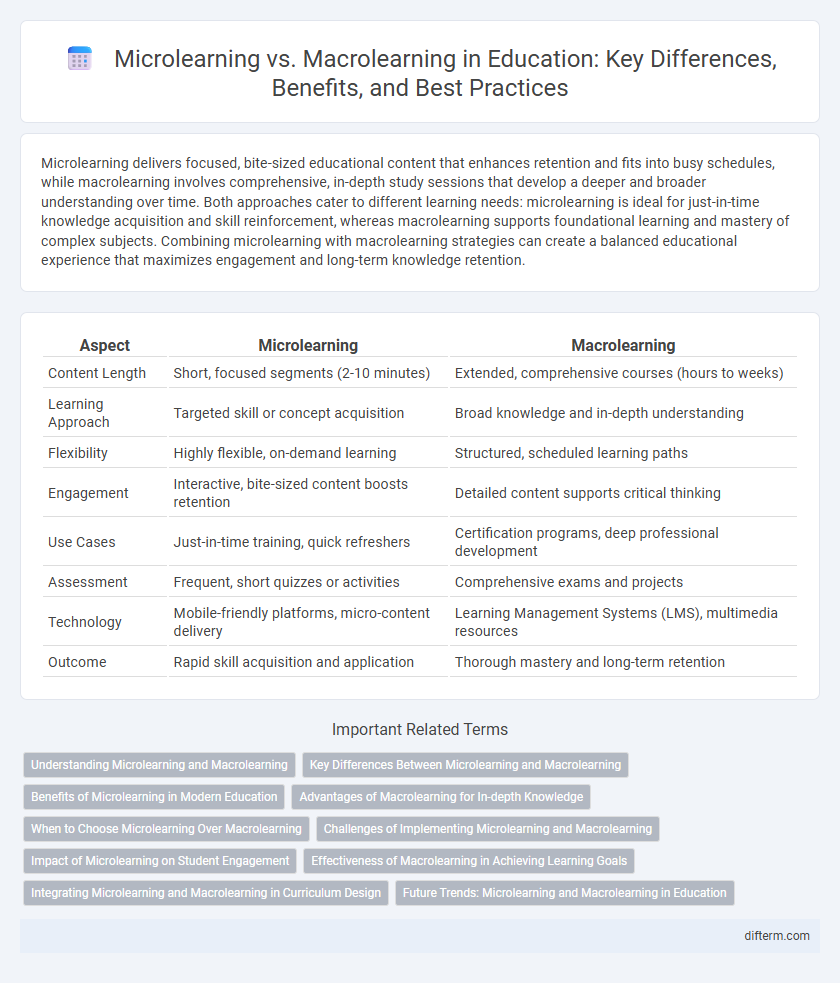Microlearning delivers focused, bite-sized educational content that enhances retention and fits into busy schedules, while macrolearning involves comprehensive, in-depth study sessions that develop a deeper and broader understanding over time. Both approaches cater to different learning needs: microlearning is ideal for just-in-time knowledge acquisition and skill reinforcement, whereas macrolearning supports foundational learning and mastery of complex subjects. Combining microlearning with macrolearning strategies can create a balanced educational experience that maximizes engagement and long-term knowledge retention.
Table of Comparison
| Aspect | Microlearning | Macrolearning |
|---|---|---|
| Content Length | Short, focused segments (2-10 minutes) | Extended, comprehensive courses (hours to weeks) |
| Learning Approach | Targeted skill or concept acquisition | Broad knowledge and in-depth understanding |
| Flexibility | Highly flexible, on-demand learning | Structured, scheduled learning paths |
| Engagement | Interactive, bite-sized content boosts retention | Detailed content supports critical thinking |
| Use Cases | Just-in-time training, quick refreshers | Certification programs, deep professional development |
| Assessment | Frequent, short quizzes or activities | Comprehensive exams and projects |
| Technology | Mobile-friendly platforms, micro-content delivery | Learning Management Systems (LMS), multimedia resources |
| Outcome | Rapid skill acquisition and application | Thorough mastery and long-term retention |
Understanding Microlearning and Macrolearning
Microlearning delivers content in small, focused bursts, enhancing retention and engagement by targeting specific skills or topics. Macrolearning encompasses comprehensive, in-depth educational experiences, facilitating mastery over broader subjects and long-term knowledge development. Effective education strategies balance microlearning's agility with macrolearning's depth to optimize learning outcomes.
Key Differences Between Microlearning and Macrolearning
Microlearning delivers content in brief, focused segments typically under 10 minutes, promoting quick knowledge retention and flexibility for learners. Macrolearning encompasses longer, comprehensive learning sessions designed to build deep understanding and complex skill acquisition over extended periods. The key difference lies in microlearning's emphasis on convenience and immediate application, while macrolearning prioritizes thorough mastery and integration of concepts.
Benefits of Microlearning in Modern Education
Microlearning enhances knowledge retention by delivering content in short, focused bursts tailored to learners' attention spans, leading to increased engagement and reduced cognitive overload. This method supports flexible, on-demand access through mobile devices, enabling learners to integrate education seamlessly into busy schedules. Efficient for skills training and continuous professional development, microlearning fosters adaptive learning environments optimized for modern education needs.
Advantages of Macrolearning for In-depth Knowledge
Macrolearning provides comprehensive and detailed exploration of subjects, enabling learners to develop a deep understanding and retain complex information over time. It supports critical thinking and the ability to connect concepts across disciplines, enhancing long-term academic and professional competence. Extended learning sessions in macrolearning facilitate mastery of intricate topics that microlearning's brief segments may not adequately cover.
When to Choose Microlearning Over Macrolearning
Microlearning is ideal for delivering targeted, concise lessons that address specific skills or knowledge gaps, especially in fast-paced environments requiring quick retention and application. It suits learners who benefit from short, focused modules that can be accessed on-demand, enhancing flexibility and engagement. Macrolearning is better reserved for comprehensive understanding and mastery of complex topics requiring deep cognitive processing and extended study sessions.
Challenges of Implementing Microlearning and Macrolearning
Implementing microlearning faces challenges such as ensuring content coherence and maintaining learner engagement in short, focused modules, which can lead to fragmentation of knowledge if not well-integrated. Macrolearning poses difficulties with time management and learner motivation due to its lengthier format, often resulting in cognitive overload and reduced retention. Both methods require careful instructional design to balance content depth, learner needs, and accessibility for optimal educational outcomes.
Impact of Microlearning on Student Engagement
Microlearning significantly boosts student engagement by delivering content in short, focused bursts that cater to limited attention spans and promote active learning. Its bite-sized lessons facilitate better retention and frequent knowledge reinforcement, enhancing motivation and participation. Compared to macrolearning, microlearning's flexible and personalized approach fosters continuous interaction and immediate application of skills in educational settings.
Effectiveness of Macrolearning in Achieving Learning Goals
Macrolearning structures comprehensive educational content over extended periods, enabling deep understanding and long-term retention. It supports complex skill development by integrating interconnected concepts and promoting cognitive elaboration, which microlearning's fragmented approach often lacks. Research highlights higher achievement levels and better transfer of knowledge in macrolearning compared to isolated microlearning modules.
Integrating Microlearning and Macrolearning in Curriculum Design
Integrating microlearning and macrolearning in curriculum design enhances learner engagement by combining brief, focused modules with comprehensive, in-depth lessons. This blended approach supports knowledge retention through repetitive, bite-sized content while maintaining a coherent, overarching educational framework. Effective curriculum design leverages microlearning for skill reinforcement and macrolearning for conceptual understanding, creating a balanced and adaptive learning environment.
Future Trends: Microlearning and Macrolearning in Education
Future trends in education emphasize the integration of microlearning and macrolearning to maximize learner engagement and retention. Microlearning delivers concise, targeted content ideal for just-in-time training and skill reinforcement, while macrolearning offers comprehensive, in-depth modules suited for foundational knowledge and complex subjects. Emerging technologies like AI-driven adaptive platforms are enhancing the seamless blend of both methods, personalizing learning experiences to meet diverse educational needs.
microlearning vs macrolearning Infographic

 difterm.com
difterm.com